Input interpretation

AgNO_3 silver nitrate + HBr hydrogen bromide ⟶ HNO_3 nitric acid + AgBr silver bromide
Balanced equation
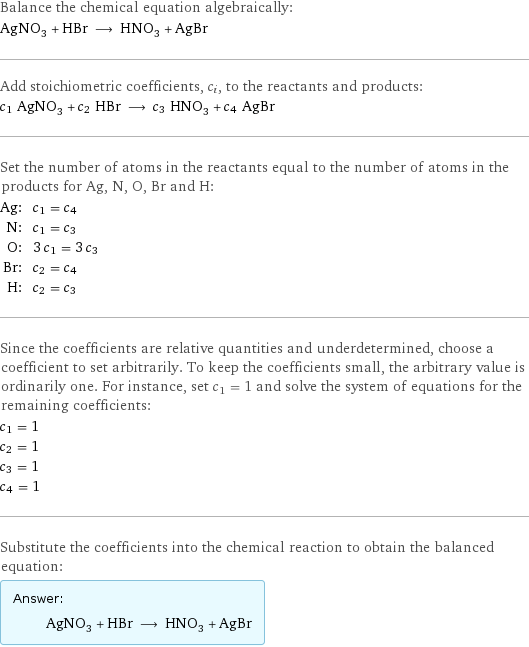
Balance the chemical equation algebraically: AgNO_3 + HBr ⟶ HNO_3 + AgBr Add stoichiometric coefficients, c_i, to the reactants and products: c_1 AgNO_3 + c_2 HBr ⟶ c_3 HNO_3 + c_4 AgBr Set the number of atoms in the reactants equal to the number of atoms in the products for Ag, N, O, Br and H: Ag: | c_1 = c_4 N: | c_1 = c_3 O: | 3 c_1 = 3 c_3 Br: | c_2 = c_4 H: | c_2 = c_3 Since the coefficients are relative quantities and underdetermined, choose a coefficient to set arbitrarily. To keep the coefficients small, the arbitrary value is ordinarily one. For instance, set c_1 = 1 and solve the system of equations for the remaining coefficients: c_1 = 1 c_2 = 1 c_3 = 1 c_4 = 1 Substitute the coefficients into the chemical reaction to obtain the balanced equation: Answer: | | AgNO_3 + HBr ⟶ HNO_3 + AgBr
Structures
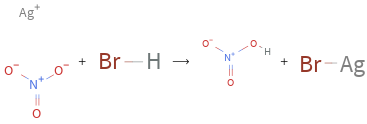
+ ⟶ +
Names

silver nitrate + hydrogen bromide ⟶ nitric acid + silver bromide
Reaction thermodynamics
Gibbs free energy
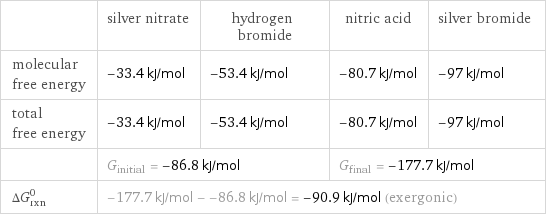
| silver nitrate | hydrogen bromide | nitric acid | silver bromide molecular free energy | -33.4 kJ/mol | -53.4 kJ/mol | -80.7 kJ/mol | -97 kJ/mol total free energy | -33.4 kJ/mol | -53.4 kJ/mol | -80.7 kJ/mol | -97 kJ/mol | G_initial = -86.8 kJ/mol | | G_final = -177.7 kJ/mol | ΔG_rxn^0 | -177.7 kJ/mol - -86.8 kJ/mol = -90.9 kJ/mol (exergonic) | | |
Entropy
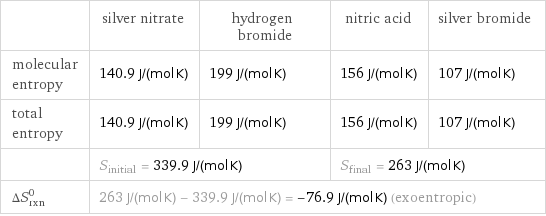
| silver nitrate | hydrogen bromide | nitric acid | silver bromide molecular entropy | 140.9 J/(mol K) | 199 J/(mol K) | 156 J/(mol K) | 107 J/(mol K) total entropy | 140.9 J/(mol K) | 199 J/(mol K) | 156 J/(mol K) | 107 J/(mol K) | S_initial = 339.9 J/(mol K) | | S_final = 263 J/(mol K) | ΔS_rxn^0 | 263 J/(mol K) - 339.9 J/(mol K) = -76.9 J/(mol K) (exoentropic) | | |
Equilibrium constant
![Construct the equilibrium constant, K, expression for: AgNO_3 + HBr ⟶ HNO_3 + AgBr Plan: • Balance the chemical equation. • Determine the stoichiometric numbers. • Assemble the activity expression for each chemical species. • Use the activity expressions to build the equilibrium constant expression. Write the balanced chemical equation: AgNO_3 + HBr ⟶ HNO_3 + AgBr Assign stoichiometric numbers, ν_i, using the stoichiometric coefficients, c_i, from the balanced chemical equation in the following manner: ν_i = -c_i for reactants and ν_i = c_i for products: chemical species | c_i | ν_i AgNO_3 | 1 | -1 HBr | 1 | -1 HNO_3 | 1 | 1 AgBr | 1 | 1 Assemble the activity expressions accounting for the state of matter and ν_i: chemical species | c_i | ν_i | activity expression AgNO_3 | 1 | -1 | ([AgNO3])^(-1) HBr | 1 | -1 | ([HBr])^(-1) HNO_3 | 1 | 1 | [HNO3] AgBr | 1 | 1 | [AgBr] The equilibrium constant symbol in the concentration basis is: K_c Mulitply the activity expressions to arrive at the K_c expression: Answer: | | K_c = ([AgNO3])^(-1) ([HBr])^(-1) [HNO3] [AgBr] = ([HNO3] [AgBr])/([AgNO3] [HBr])](../image_source/8eb2fdd121b65541fd4f6e00a773abd2.png)
Construct the equilibrium constant, K, expression for: AgNO_3 + HBr ⟶ HNO_3 + AgBr Plan: • Balance the chemical equation. • Determine the stoichiometric numbers. • Assemble the activity expression for each chemical species. • Use the activity expressions to build the equilibrium constant expression. Write the balanced chemical equation: AgNO_3 + HBr ⟶ HNO_3 + AgBr Assign stoichiometric numbers, ν_i, using the stoichiometric coefficients, c_i, from the balanced chemical equation in the following manner: ν_i = -c_i for reactants and ν_i = c_i for products: chemical species | c_i | ν_i AgNO_3 | 1 | -1 HBr | 1 | -1 HNO_3 | 1 | 1 AgBr | 1 | 1 Assemble the activity expressions accounting for the state of matter and ν_i: chemical species | c_i | ν_i | activity expression AgNO_3 | 1 | -1 | ([AgNO3])^(-1) HBr | 1 | -1 | ([HBr])^(-1) HNO_3 | 1 | 1 | [HNO3] AgBr | 1 | 1 | [AgBr] The equilibrium constant symbol in the concentration basis is: K_c Mulitply the activity expressions to arrive at the K_c expression: Answer: | | K_c = ([AgNO3])^(-1) ([HBr])^(-1) [HNO3] [AgBr] = ([HNO3] [AgBr])/([AgNO3] [HBr])
Rate of reaction
![Construct the rate of reaction expression for: AgNO_3 + HBr ⟶ HNO_3 + AgBr Plan: • Balance the chemical equation. • Determine the stoichiometric numbers. • Assemble the rate term for each chemical species. • Write the rate of reaction expression. Write the balanced chemical equation: AgNO_3 + HBr ⟶ HNO_3 + AgBr Assign stoichiometric numbers, ν_i, using the stoichiometric coefficients, c_i, from the balanced chemical equation in the following manner: ν_i = -c_i for reactants and ν_i = c_i for products: chemical species | c_i | ν_i AgNO_3 | 1 | -1 HBr | 1 | -1 HNO_3 | 1 | 1 AgBr | 1 | 1 The rate term for each chemical species, B_i, is 1/ν_i(Δ[B_i])/(Δt) where [B_i] is the amount concentration and t is time: chemical species | c_i | ν_i | rate term AgNO_3 | 1 | -1 | -(Δ[AgNO3])/(Δt) HBr | 1 | -1 | -(Δ[HBr])/(Δt) HNO_3 | 1 | 1 | (Δ[HNO3])/(Δt) AgBr | 1 | 1 | (Δ[AgBr])/(Δt) (for infinitesimal rate of change, replace Δ with d) Set the rate terms equal to each other to arrive at the rate expression: Answer: | | rate = -(Δ[AgNO3])/(Δt) = -(Δ[HBr])/(Δt) = (Δ[HNO3])/(Δt) = (Δ[AgBr])/(Δt) (assuming constant volume and no accumulation of intermediates or side products)](../image_source/17f2cd48d00ca513e302c43a74469b7a.png)
Construct the rate of reaction expression for: AgNO_3 + HBr ⟶ HNO_3 + AgBr Plan: • Balance the chemical equation. • Determine the stoichiometric numbers. • Assemble the rate term for each chemical species. • Write the rate of reaction expression. Write the balanced chemical equation: AgNO_3 + HBr ⟶ HNO_3 + AgBr Assign stoichiometric numbers, ν_i, using the stoichiometric coefficients, c_i, from the balanced chemical equation in the following manner: ν_i = -c_i for reactants and ν_i = c_i for products: chemical species | c_i | ν_i AgNO_3 | 1 | -1 HBr | 1 | -1 HNO_3 | 1 | 1 AgBr | 1 | 1 The rate term for each chemical species, B_i, is 1/ν_i(Δ[B_i])/(Δt) where [B_i] is the amount concentration and t is time: chemical species | c_i | ν_i | rate term AgNO_3 | 1 | -1 | -(Δ[AgNO3])/(Δt) HBr | 1 | -1 | -(Δ[HBr])/(Δt) HNO_3 | 1 | 1 | (Δ[HNO3])/(Δt) AgBr | 1 | 1 | (Δ[AgBr])/(Δt) (for infinitesimal rate of change, replace Δ with d) Set the rate terms equal to each other to arrive at the rate expression: Answer: | | rate = -(Δ[AgNO3])/(Δt) = -(Δ[HBr])/(Δt) = (Δ[HNO3])/(Δt) = (Δ[AgBr])/(Δt) (assuming constant volume and no accumulation of intermediates or side products)
Chemical names and formulas
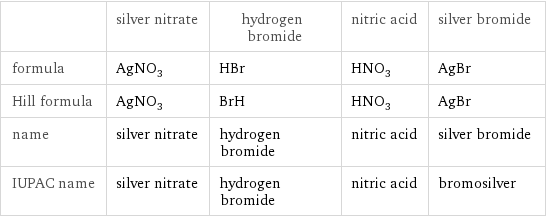
| silver nitrate | hydrogen bromide | nitric acid | silver bromide formula | AgNO_3 | HBr | HNO_3 | AgBr Hill formula | AgNO_3 | BrH | HNO_3 | AgBr name | silver nitrate | hydrogen bromide | nitric acid | silver bromide IUPAC name | silver nitrate | hydrogen bromide | nitric acid | bromosilver
Substance properties
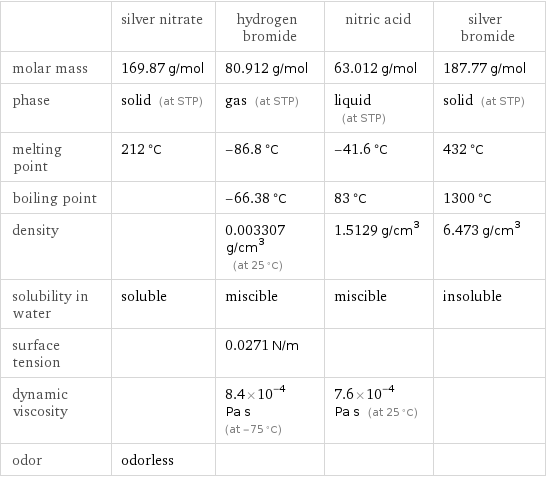
| silver nitrate | hydrogen bromide | nitric acid | silver bromide molar mass | 169.87 g/mol | 80.912 g/mol | 63.012 g/mol | 187.77 g/mol phase | solid (at STP) | gas (at STP) | liquid (at STP) | solid (at STP) melting point | 212 °C | -86.8 °C | -41.6 °C | 432 °C boiling point | | -66.38 °C | 83 °C | 1300 °C density | | 0.003307 g/cm^3 (at 25 °C) | 1.5129 g/cm^3 | 6.473 g/cm^3 solubility in water | soluble | miscible | miscible | insoluble surface tension | | 0.0271 N/m | | dynamic viscosity | | 8.4×10^-4 Pa s (at -75 °C) | 7.6×10^-4 Pa s (at 25 °C) | odor | odorless | | |
Units
